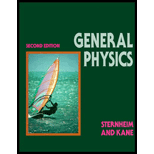
(a)
Energy emitted due to transition.
(a)
Answer to Problem 44E
The photon of energy emitted is
Explanation of Solution
Write the expression for energy of diatomic molecule.
Here,
Write the expression for change in energy due to transition.
Conclusion:
Substitute
Substitute
Substitute
Thus, the energy of photon emitted is
(b)
The wavelength of photon emitted.
(b)
Answer to Problem 44E
The wavelength of photon emitted is
Explanation of Solution
Write the expression for energy of photon emitted.
Here,
Rearrange the above expression for
Conclusion:
Substitute
Thus, the wavelength of photon emitted is
Want to see more full solutions like this?
Chapter 27 Solutions
General Physics, 2nd Edition
- What is the energy of the photon that, when absorbed by a hydrogen atom, could cause an electronic transition from the n = 2 state to the n = 5 state? Answer in units of eV. What energy could cause an electronic transition from the n = 5 state to the n = 8 state? Answer in units of eV.arrow_forwardIn X-ray fluorescence (XRF), the energy of the characteristic Ka line of iron (Fe) is 6.405 keV. Calculate the wavelength (in Å) corresponding to this line and state what electronic transition this represents. (DATA: h = 6.626 x 10-34 J s; c = 2.998 x 108 m s-1; e = 1.602 x 10-19 C)arrow_forwardThe intensity of a laser in free space is150mW / m? . The corresponding amplitude of the V (6, = 8.854x10-12 C² /N.m² ) electric field of the laser isarrow_forward
- A sodium atom of mass 3.82 * 10^-26 kg vibrates with simple harmonic motion in crystal. The potential energy increases by 0.0075 eV when the atom is displaced 0.014 nm from its equilibrium position. Find the wavelength of a photon emitted when n=6 to n=1 transition occurs.arrow_forwardCalculate the wavelength associated with an electron with energy of 1.0 eV if the electron is inside a GaAs crystal. (The mass of an electron in GaAs is 0.067 X 9.11 X 10-31 Kg)arrow_forwardA laser emits 5.50 x 1018 photons per second, using a transition from an excited state with energy 1.15 eV to a ground state with energy 0 eV. (a) What is the laser’s power output? (b) What is the wavelength?arrow_forward
- A mercury atom emits light at many wavelengths, two of which are at (1) 404.7 nm and (2) 435.8 nm . Both of these transitions are to the same final state. Determine the energy of each emitted wavelength (in J). A E1 = 7.908 x 10-19 J and E2 = 6.558 x10-19 J E1 = 4.628 x 10-19 J and E2 = 4.968 x10-19 J E1 = 5.908 x 10-19 J and E2 = 5.558 x10-19J E1 = 4.908 x 10-19 J and E2 = 4.558 x10-19 Jarrow_forwardQuestion 9. While most transition metals have work functions corresponding to photon frequencies that are larger (higher) than visible light, alkali and alkaline earth metals have low-energy work functions. For example, calcium has a work function of o = 4.3419×10-19 J. (a) What is the initial state n, for the hydrogen emission lines at visible wavelengths (i.e., those with n = 2) for the lowest-energy photon that would eject an electron from calcium? %3! (b) If the colors of the visible hydrogen emission lines (n; = 3 to n = 6) are red, green, blue and %3D violet, which colors are capable of ejecting the electrons from calcium? (c) The energy of the emitted photon you identified in part (a), is not identical to the workfunction of calcium. Therefore, the electron is ejected from the metal surface with some kinetic energy (i.e., energy is conserved in the photoelectric effect process). What would the velocity of the electron ejected from calcium (in meters per second)?arrow_forwarda)Suppose a hydrogen molecule in its ground state is dissociated by absorbing a photon of ultraviolet light, causing the two hydrogen atoms to fly apart. What photon energy will give each atom a speed of 19 km/s? The mass of a hydrogen atom is 1.7×10^−27 kg Express your answer to two significant figures and include the appropriate units.arrow_forward
- How many photons are emitted per second from a semiconductor laser which emits 0.75 mW of light at a wavelength of 540 nm? O 239E+15 O 2.04E+15 O 2.85E+15 O 3.21E+15arrow_forwardAn electron undergoes a transition from the 3rd energy level to the 1st energy level in a hydrogen atom. The wavelength of the radiation associated with this transition is a.bc x 10* d m. Record abcd. Selected Energy Levels for Hydrogen -0.544 eV -0.850 eV -1.51 eV -3.40 eV N=4 N=3 N=2 -13.6 eVarrow_forwardUse the table to determine the energy in eV of the photon absorbed when an electron jumps up from the n = 1 orbit to the n = 3 orbit of a hydrogen atom. Allowed Values of the Hydrogen Electron's Radius and Energy for Low Values of n n rn En 1 0.053 nm −13.60 eV 2 0.212 nm −3.40 eV 3 0.477 nm −1.51 eV 4 0.848 nm −0.85 eVarrow_forward

 Principles of Physics: A Calculus-Based TextPhysicsISBN:9781133104261Author:Raymond A. Serway, John W. JewettPublisher:Cengage Learning
Principles of Physics: A Calculus-Based TextPhysicsISBN:9781133104261Author:Raymond A. Serway, John W. JewettPublisher:Cengage Learning

